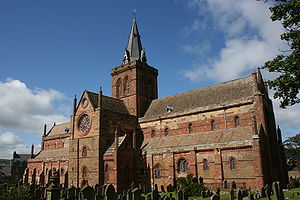
Saint Magnus was born in 1075, the son of Erlend Thorfinnsson, Earl of Orkney. Magnus served as chamberlain to the king of Norway. The king took possession of the Orkney Islands in 1098. Magnus had gained a reputation for piety and gentleness. When the King of Norway led a raid on Anglesey, Wales, Magnus refused to fight and stayed on board his ship, singing psalms. Later, another King of Norway granted Magnus a share of the earldom of Orkney and he and his cousin, Haakon ruled amicably from 1105 to 1114. Eventually the followers of the joint earls had a disagreement. The two sides met at an assembly on the Orkney Mainland, armed for battle. Instead, a rendezvous was negotiated and the Earls arranged to meet on the island of Egilsay, each bringing two ships.
On April 16, 1116, Magnus arrived with his two ships but his cousin brought eight ships. Magnus managed to escape and took refuge in the island’s church overnight. The following day he was captured and offered to go into exile or prison but some of the chieftains insisted that one of the earls must die. Haakon ordered his standard bearer to kill Magnus but he refused. Haakon then made his cook kill Magnus by striking him on the head with an axe. Before he died, legend says he prayed for his executioners.
Magnus was buried in the Christchurch at Birsay. Numerous reports of miracles and healings began to occur. He was canonized in 1135 and his remains were moved to St. Olaf’s Kirk in Kirkwall. Eventually, Magnus’ nephew, Rognvald Kali Kolsson made claim to the Earldom of Orkney and his father Kol advised him to promise the islanders he would build a stone minster at Kirkwall in memory of his holy uncle. Construction began on a stone church in 1137 in the Norman style of architecture. Much of the original stonework was created by master masons believed to have been trained at Durham Cathedral.

A polychromatic effect was created by using red sandstone and yellow sandstone, all quarried from the islands. Although there has been some erosion, examples of the original work can still be seen in the south transept doorway and around the three doorways in the west end. When the Cathedral was consecrated, the relics of St. Magnus were enshrined in the new building. In 1917, a hidden cavity in a column was found and it contained a box with bones. The bones included a skull showing a wound consistent with a blow from an axe. It is believed, without much doubt, these are the bones of Magnus.
In the late twelfth and early thirteenth century the building was extended to the east with vaulting throughout. In the late fourteenth century the present lower front was joined to the rest of the building. All these later additions were done in the Gothic style of architecture with pointed arches. Between 1154 and 1472, Orkney was ecclesiastically under the Norwegian archbishop of Trondheim. After 1472, it became a part of the Scottish province of St. Andrews. The Cathedral was assigned to the inhabitants of Kirkwall by King James III of Scotland by charter in 1486.
The Reformation has less effect on St. Magnus than in other parts of Scotland. The original spire was struck by lightning in the late seventeenth century. In 1845, the government resumed ownership of St. Magnus, expelling the congregation and doing major restoration work on the fabric of the building. In 1851, Kirkwall again took ownership and gave the choir new galleries and the presbytery new pews.
The Cathedral slowly deteriorated until the early twentieth century. A grant was made to do major restoration. The pyramid style top of the tower was replaced with a spire covered in copper sheeting. The plain windows were replaced with stained glass, the floor was tiled and plaster and whitewash were removed from the walls, exposing the red sandstone on the interior. Work is still being done today. It was discovered in the 1970’s that the west end of the Cathedral was in danger of collapsing.

One of the most unique features of the Cathedral is its dungeon, known as Marwick’s Hole, although no one knows why. It supposedly dates from the sixteenth century. Originally the Hall of Justice overhead had a chute to slide prisoners down. The door was closed and the occupant would be in total darkness with no outlet for escape.
On the 850th anniversary of the Cathedral in 1987, Queen Elizabeth II came and unveiled a new west window. St. Magnus Cathedral is the most northerly cathedral in the British Isles, the only solely medieval Scottish Cathedral and one of the best preserved buildings of the medieval era in Britain.
Reblogged this on History's Untold Treasures and commented:
H/T The Freelance History Writer
LikeLike
Interesting tours to the upper levels of the cathedral on a Tuesday and Thursday @ 11am & 2pm.
LikeLike
Thanks for the article. Brought back memories of being in the Orkneys and Shetlands.
LikeLike
You’re welcome Gerald. It’s a wonderful building.
LikeLike
Interesting article. The cathedral has quite a history.
LikeLike
Fascinating historical perspective! It looks like a magnificent cathedral with a wealth of history. Now we just need to find out who Marwick was!!
LikeLike
I know Nancy! That would be a good piece of historical investigation. Why am I thinking he was a prisoner in the dungeon?
LikeLike